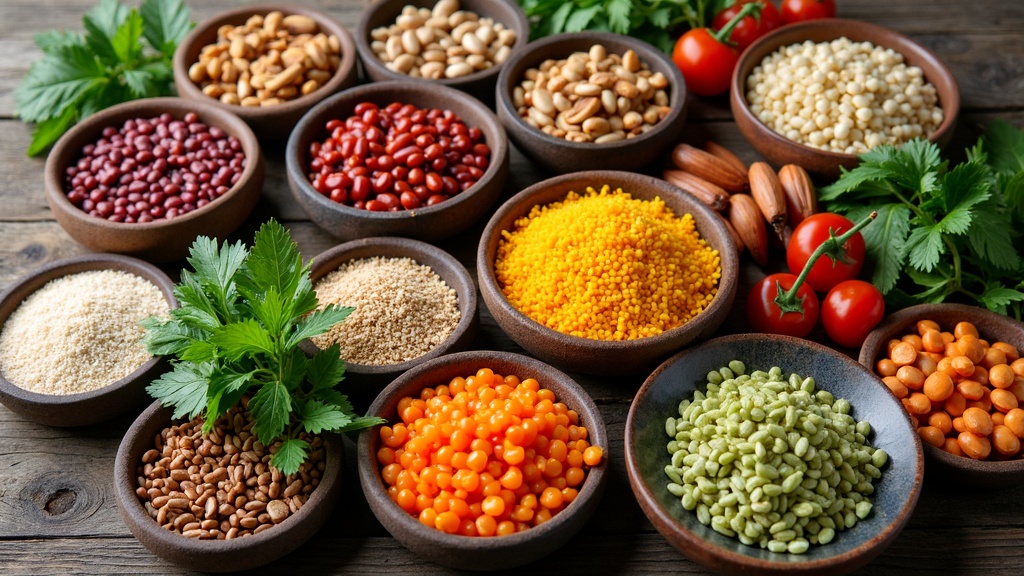Finding delicious and filling plantbased proteins isn’t just possible—it’s a lot easier these days thanks to a variety of foods you can work into every meal. Whether you’re vegan, vegetarian, or just trying to eat more plants, there’s a solid lineup of protein-packed options that’ll keep you fueled and satisfied from breakfast to dinner. I’m walking through some popular choices and sneaky sources, along with tips for making the most of your meals.

Why Plantbased Protein Matters
Plantbased proteins offer a practical way to meet your daily nutritional needs while skipping animal products. They’re low in saturated fats and often come bundled with fiber, vitamins, and minerals. A lot of folks ask if plant proteins actually stack up to animal proteins. The answer is yes; they can, as long as you get a variety. Mixing different plant proteins covers your bases, since some foods may lack one or two amino acids that others provide.
Current studies show that a well-planned plant-forward diet can offer plenty of protein to fuel workouts, support muscle growth, and keep energy up throughout the day. Plus, choosing plants for protein can be good for your gut and even help lower environmental impact compared to meat-heavy diets. More people are recognizing that getting protein from plants is a smart move for overall health.
Best Plant-based Proteins for Every Meal
Each meal gives you a chance to work in different plant-derived proteins. These foods aren’t just for vegans; they’re ideal for anyone wanting more variety on their plate. Here are some tasty picks to try throughout the day:
- Legumes: Beans, lentils, chickpeas, and peas are packed with protein and fiber, making them a hearty addition to anything from soups to stews.
- Whole Grains: Quinoa, farro, bulgur, oats, and brown rice all contain solid amounts of protein per serving, and they help round out meals with complex carbs too.
- Soy Products: Tofu, tempeh, and edamame are soy’s answers to chewy, hearty proteins.
- Nuts and Seeds: Almonds, peanuts, chia seeds, hemp seeds, and pumpkin seeds bring protein along with healthy fats. They’re perfect for snacking or as meal toppers.
- Seitan and Wheatbased Proteins: Seitan offers a meaty texture and high protein content, making it handy for sandwiches or stirfries.
Building Proteinrich Meals by Time of Day
I like to break down meal ideas by what works best when. Here’s how I work plant-based proteins into breakfast, lunch, and dinner:
Breakfast
- Oats: Rolled or steelcut oats are pretty filling. I often stir in peanut butter or sprinkle hemp seeds and slivered almonds on top for an extra protein boost.
- Soy Yogurt and Tofu Scramble: Unsweetened soy yogurt paired with berries and granola can be an easy, high-protein breakfast. Tofu scramble stands in for eggs, offering a very similar amount of protein per serving.
- Chia or Flaxseed Pudding: Soak chia or flaxseeds in your favorite plantbased milk. Add fruit and nuts for more flavor and protein.
Another quick idea: use high-protein granola with plant-based milk for a grabandgo option. Try blending oats and nuts into your morning smoothie for even more staying power.
Lunch
- Lentil or Chickpea Salad: Lentils snap into salads or wraps, and canned chickpeas can be mashed for filling sandwiches. Mixing in whole grains like farro or quinoa helps boost protein even further.
- Stuffed Sweet Potatoes: Bake a sweet potato and stuff it with black beans, corn, salsa, and a dollop of cashew cream or avocado for a filling meal.
- Veggie Burgers: Try homemade burgers using black beans, oats, and chopped veggies. Even store-bought options now tend to supply more protein than you’d expect.
Soups are another lunchtime favorite. Lentil soup or split pea soup is not only comforting but also packed with protein. Don’t forget about sushi made with brown rice and tofu for something different.
Dinner
- Stir-fries with Tofu or Tempeh: Sauté seasonal veggies with diced tofu or tempeh and a splash of tamari. It’s an easy way to pack in protein and flavor.
- Curry with Lentils or Chickpeas: Lentils cook quickly, and chickpeas hold their shape well in curries. Coconut milk, ginger, and spices turn everything creamy and satisfying.
- Pasta with Edamame or Pea Protein: Edamame can be tossed into pasta dishes, while newer pastas made from lentils, chickpeas, or peas offer a nice protein boost too.
For a twist, try roasted cauliflower steaks topped with a rich, nutty sauce or even creamy risotto made with peas and nutritional yeast for added protein flavor.
Important Things to Know About Plant-based Proteins
I’ve learned that eating a variety of plantbased proteins fills in the gaps some individual foods might have. Here are a few handy things to consider when planning out your meals:
- Complete vs. Incomplete Proteins: Some plant proteins are considered “incomplete” because they lack a few amino acids. However, eating a mix of different sources throughout the day balances things out; no need to combine foods in one sitting.
- Pairings Help: Rice and beans is a classic combo, and for good reason. Even toast with peanut butter covers lots of bases in terms of amino acids.
- Iron and B12: While plant-based proteins cover most needs, iron from plants isn’t as easily absorbed. Eating sources along with vitamin Crich foods such as bell peppers or oranges helps with absorption. B12 usually needs supplementing or comes from fortified products like plant milks.
Complete Proteins: Where to Track Down Them
Quinoa, tofu, tempeh, edamame, and buckwheat are examples of plant-based foods that give you all essential amino acids. They’re pretty easy to work into meals when you want a complete protein without thinking twice. Adding these into soups, bowls, or stirfries ensures you get the full range of amino acids.
Soaking and Cooking Tips for Better Nutrition
Soaking beans and lentils before cooking can reduce compounds that make some people feel bloated or gassy. Cooking grains thoroughly and rinsing them well also helps make protein more easily available for your body. Preparing seeds and nuts by roasting or toasting can make them tastier and help with digestion.
Watch Out for Highly Processed Foods
Plant-based meat alternatives can be found almost everywhere now. Some can be great for protein, but it’s smart to check ingredient lists. Heavily processed options may have more sodium and less nutrients overall, so I suggest saving them for when you really want the convenience or flavor punch. Sticking to wholefoods most of the time puts you on track for the best nutrition.
Simple Tips to Boost Plantbased Protein Intake
Here are a few quick strategies I use to meet protein needs without giving it too much thought:
- Sprinkle Seeds Everywhere: Hemp, chia, and flax-seeds fit into smoothies, salads, and even baked goods.
- Swap in Legumes: Use black beans in tacos, lentils in soups, or chickpeas in pasta salads. They’re easy to batch-cook or buy canned for quick meals.
- Upgrade Your Snacks: Keep roasted chickpeas, trail mix, or nut butter with apple slices handy so you get protein on the go.
- Double Up Soy Products: A little tofu in your stirfry and a handful of edamame as a side add up fast for a strong protein punch.
- Try Highprotein Grains: Quinoa and buckwheat aren’t just for dinner; add them to breakfast bowls or baked goods for a subtle boost.
Mixing these habits into your daily eating plan will make it simple to raise your protein intake, which is helpful if you work out, have a busy schedule, or just want to stay full between meals. Don’t forget to try new recipes or global cuisines to keep things interesting while hitting your nutrition targets.
What About Protein Powders?
If you’re active or busy, plantbased protein powders offer a quick boost. Powders from peas, brown rice, hemp, and soy are common, and many brands blend ingredients to provide all the essential amino acids. I use them most when making smoothies after a workout. Just check for sweeteners or additives if you like simple products. Mixing protein powder into overnight oats or pancake batter is another clever way to up protein intake without much effort.
Frequently Asked Questions
Here are some common questions people have about adding plant-based proteins to their meals:
Question: Can I get enough protein without animal products?
Answer: Absolutely. With a variety of legumes, whole grains, soy foods, nuts, and seeds, it’s pretty straight-forward to meet protein needs, especially with some planning.
Question: Do I need to combine foods at the same meal to make a ‘complete’ protein?
Answer: No. As long as you eat a range of plant protein sources throughout the day, your body stores and recycles amino acids, so strict combining at every meal isn’t necessary.
Question: What are some highprotein snacks?
Answer: Roasted chickpeas, trail mix with nuts and seeds, edamame, and even storebought protein bars made with pea or soy protein are convenient options. Nut butters on wholegrain crackers or smoothies with added seeds also make for satisfying snacks.
Question: How much protein do I need daily?
Answer: Most adults need 0.8 grams of protein per kilogram of body weight, but active people might need more. Using online calculators or checking in with a dietitian helps personalize this number and ensure you’re on track.
Wrapping Up
Working plant-based protein into every meal is seriously doable, and actually pretty tasty once you know your options. Loading up on a mix of beans, grains, soy foods, nuts, and seeds keeps your meals balanced, filling, and packed with nutrients. Whether you’re prepping breakfast, throwing together lunch, or getting creative at dinner, the choices for plant-powered protein are better than ever.
Trying out new ingredients or dishes from global cuisines is a fun way to keep things interesting, and a little creativity goes a long way in making every meal satisfying and packed with protein. Embracing plantbased proteins can lead to a healthy lifestyle, offer variety, and step up your health for the long run.
